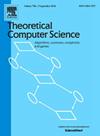最大核心生成树维护大型动态图
IF 1
4区 计算机科学
Q3 COMPUTER SCIENCE, THEORY & METHODS
引用次数: 0
摘要
随着网络规模和在线应用的增加,大图中内聚结构的维护问题引起了人们的广泛关注。最大核心生成树(Maximum Core Spanning Tree, MCST)是基于k-core生成的具有代表性的内聚结构,它是一棵最大边权生成树,表示每个连接组件的“分层核心层次”。这里的边权定义为wuv=min {core(u),core(v)}, core(x)是顶点x的角度。与已知高效算法的最大生成树(MST)的维护问题不同,MCST的维护提出了特殊的挑战,这主要是由于单边插入或删除后级联的顶点核度变化。本文给出了MCST的一系列性质和MCST维护问题,并提出了OrderPassed方法和LoopFree方法来有效地维护MCST。其中,插入和删除边的MCST维护的时间复杂度分别为O(|E |+|V|)和O(|E |+∑i=1K|Oi|),其中,E为插入/删除后边权值发生变化的边集,|Oi|为边权值为i的边的个数。通过广泛的评估,我们表明所提出的MCST维护算法在真实数据集上具有良好的效率、可扩展性和稳定性。本文章由计算机程序翻译,如有差异,请以英文原文为准。
Maximum core spanning tree maintenance for large dynamic graphs
With the increase in network scale and online applications, the maintenance problem of cohesive structures in large graphs has attracted great attention. The Maximum Core Spanning Tree (MCST) is a representative cohesive structure generated based on k-core, which is the maximum edge weight spanning tree indicating the “staired coreness hierarchy” in each connected component. The edge weight here is defined as , and is the corness of vertex x. Unlike the maintenance problem of Maximum Spanning Tree (MST) which has known efficient algorithms, MCST maintenance raises special challenges, which is mainly due to the cascaded vertex coreness changes after single-edge insertion or deletion. In this paper, we show a series properties of MCST and MCST maintenance problems and propose an OrderPassed method and a LoopFree method to maintain the MCST efficiently. In particular, the time complexity for MCST maintenance for edge insertion and deletion is bounded by and respectively, where is the edge set whose edge weight changes after insertion/deletion and denotes the number of edges whose edge weight is i. Through extensive evaluations, we show the proposed MCST maintenance algorithms have good efficiency, scalability and stability on real-world datasets.
求助全文
通过发布文献求助,成功后即可免费获取论文全文。
去求助
来源期刊

Theoretical Computer Science
工程技术-计算机:理论方法
CiteScore
2.60
自引率
18.20%
发文量
471
审稿时长
12.6 months
期刊介绍:
Theoretical Computer Science is mathematical and abstract in spirit, but it derives its motivation from practical and everyday computation. Its aim is to understand the nature of computation and, as a consequence of this understanding, provide more efficient methodologies. All papers introducing or studying mathematical, logic and formal concepts and methods are welcome, provided that their motivation is clearly drawn from the field of computing.
 求助内容:
求助内容: 应助结果提醒方式:
应助结果提醒方式:


